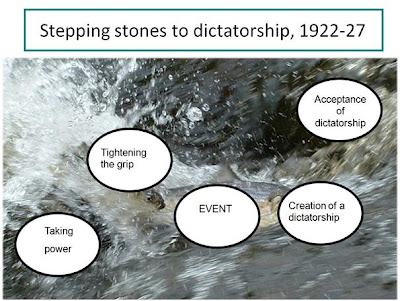Cause and consequence appears as the fourth key concept on the QCDA KS3 National Curriculum, and underpins much of our study of history as a discipline. Come GCSE and A Level it’s still key as students begin to make a distinction between conditional and contingent causes, immediate and delayed consequences. Whilst I have found my students handle the idea of a cause followed by an event leading to a consequence well, they often find it more difficult to really explain how the cause caused the event, and why the consequence is a consequence. Chronological ordering is one thing, supported historical analysis another!
The idea behind this activity is to get students to explain causation from one event to the next. I have used it with Year 7 explaining the collapse of the Roman Empire, Year 10 searching for the causes of the October 1917 Revolution and Year 12 analysing Mussolini’s rise to power. What I have seen in all is both how students are constructively critical of each other’s arguments, and how they offer help and suggestions of explanation to a peer teetering perilously on a stepping stone in the middle of the ‘stream’.
The activity
Using the stepping stone template, the students write each cause and consequence on individual stones. I usually photocopy the template up so that each stone is A4. They also need one central stone called ‘EVENT’ on which they write details of the event whose causes and consequences they are analysing, this can be done individually or in small groups.
I get students to make their notes on the templates in bullet points, or single prompt words, rather than continuous prose. The reason being they place the stones on the floor and need to be able to read them easily whilst standing!
Students then lay their stones across the floor, which becomes a stream, in chronological order – causes -> event -> consequences. In order to step onto each stone they must explain either how it is a cause, or why it is a consequence. This also allows for the construction of a continuous argument.
If their teammates think the explanation is adequate they are able to step onto the stone, and then explain the next in order to step, one at a time, right across the stream. The ‘event’ stone can either be a temporary respite, or students can narrate the event as part of their ongoing explanation. Should any student fail to match up to their teammates expectations, they risk slipping off the stone into the stream and either have to start again, or become a soggy spectator as the next member of the team takes their chances!
The quality of explanation and ensuing discussions were really pleasing; Year 7 were able to make links between the causes of the fall of Rome and the ensuing consequences. At A Level the activity highlights the conditional or contingent status of causes, and demonstrates the interrelation of consequences.
 |
| Example PowerPoint slide using stepping stones to explain Mussolini’s rise to power as AS level |
Download the stepping stone template for yourself here to try this activity out with your own classes!


